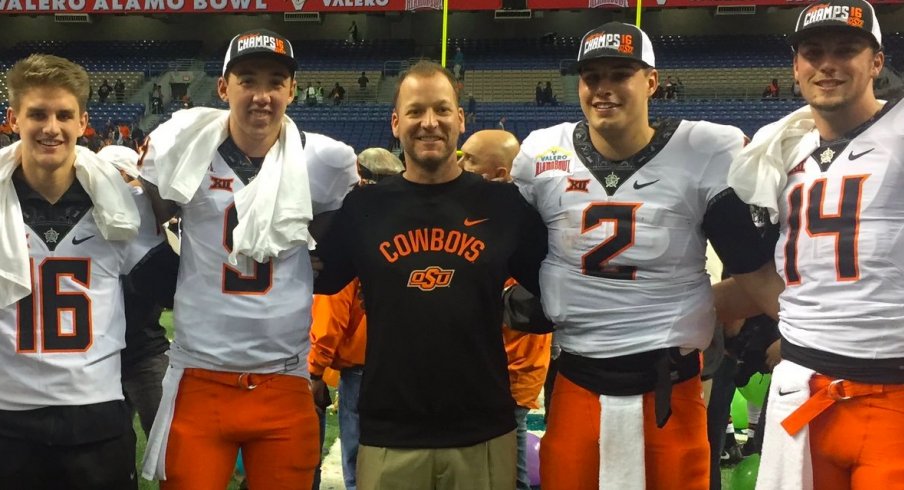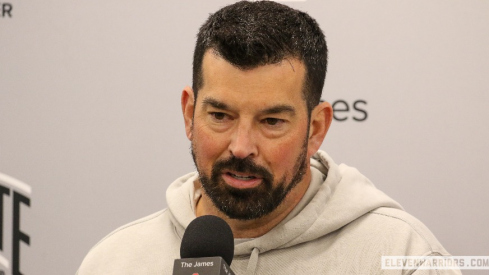The route from Euclid High School on E. 222nd Street to Ohio Stadium is exactly 153 miles long and takes the average driver two-and-a-half hours to complete.
For many kids growing up in this lakefront suburb which borders Cleveland's east side, that trek south down I-71 may be a dream, but one which has come true before. While the public high school is often overshadowed by neighboring Villa Angela-St Joseph with its 19 state championships and a list of famous alumni such as Clark Kellogg and the Golic brothers, the area was a factory of football talent during the 1980s and 90s.
While Desmond Howard, Elvis Grbac, and the private school on E. 185th St came just short of a state title in 1987, both Big Ten recruits were overshadowed by a sophomore running back from Euclid named Robert Smith who'd go on to win the coveted title of Ohio's 'Mr. Football' in both '88 and '89. Just a few years later, another Panther would follow Smith south, as Pepe Pearson toted the rock for nearly 1,500 yards as a junior at Ohio State in 1996.
Not everyone's path would be so direct, however.
While Pearson was competing for national titles with the Buckeyes, another Euclid High alum was trying to do the same as a receiver at California. However, instead of going west to Berkeley, Mike Yurcich had gone east, to the Division II California University of Pennsylvania, just south of Pittsburgh.
As a wideout for the Vulcans, Yurcich didn't win quite as many games in college as his high school teammate. Though he'd been a decorated coach at Georgetown College in Kentucky, then-California head coach Kevin Donley was fired after Yurcich's sophomore year after a posting a four-year record of only 11-33.
Once Yurcich graduated in 1999, he'd reunite with Donley, this time at NAIA University of St. Francis in Indiana. After a four-year stint coaching running backs, quarterbacks, and eventually coordinating the entire offense, Yurcich finally got his taste of big-time college football as a graduate assistant on Gerry DiNardo's staff at Indiana University in 2003 and 2004.
When DiNardo was fired by the Hoosiers following the '04 campaign, Yurcich went back to the Pennsylvania State Athletic Conference, this time at Edinboro College outside of Erie. While coaching quarterbacks and receivers for the Fighting Scots, he was given play-calling duties until 2010 when he moved east once again.
Once hired as offensive coordinator for PSAC rival Shippensburg University, Yurcich finally began to carve out a niche that would separate him from other journeyman coaches. After decades of running a listless Wing-T offense, the Raiders installed a dynamic spread system under Yurcich that was multiple both in philosophy and formation.
Yurcich simplified the blocking schemes up front and spread the field out wide, creating running lanes for both his running backs and quarterbacks who were all of a sudden running the zone-read. Once the ground game was established, Yurcich wasn't afraid to take the top off and attack with play-action, pulling linemen to sell the run fake before looking downfield.
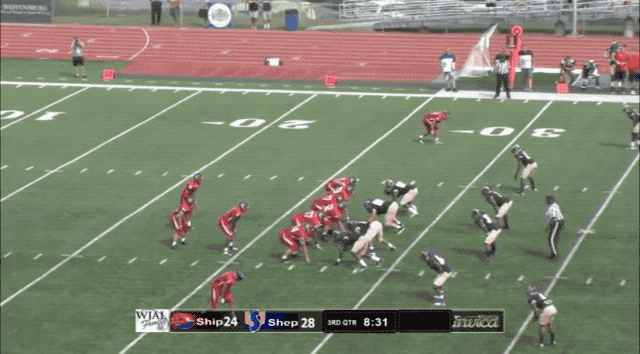
Not only did this new approach shatter school records, but it led the nation in total yards in 2012 and earned quarterback Zach Zulli the Harlan Hill award as the top player in Division-II as the Raiders went 11-2.
This success famously caught the eye of Oklahoma State head coach Mike Gundy, who was searching for a replacement for departed coordinator Todd Monken, who left to take the head job at Southern Mississippi (and is now OC for the Cleveland Browns). After searching online, Gundy stumbled upon the D-II statistics page only to find 'Shippensburg' at the top of nearly every category, leading him to reach out.
As Yurcich told Bill Connelly of SBNation, the process of moving to the Big 12 caught him off-guard:
“I was on the road recruiting,” Yurcich says, “and got a call from our running backs coach. He said, ‘Oklahoma State wants some film on you,’ and I was like, ‘Okay, really, wow, make sure you get some film to them.’” He thought it was more to pull ideas from what Shippensburg was doing. “It didn’t really register that they had an open job and that that’s what he was doing. But then he called the next day, and I set up an interview, and away it went.”
With the personnel he was returning, Gundy appeared more interested in input and tweaks, not wholesale changes. “He didn’t want to change systems,” Yurcich says. “He’s like, just learn our stuff — it’s basically the same stuff you’re running. A lot of the stuff I was running, some of it I made up and most of it I stole. It was an easy transition. I just had to learn the language.”
Once in Stillwater, Yurcich was baptized into a system built by Gundy, but heavily influenced by the trio of coordinators that left for head coaching gigs following their time calling plays for the Cowboys. In addition to Monken, Larry Fedora and Dana Holgorsen each left their fingerprints on Gundy's playbook before moving on to bigger things, topping statistical leaderboards along the way.
Gundy, of course, was once the Cowboys' quarterback himself, throwing 49 touchdown passes and setting the Big 8 conference record for career passing yardage after he earned the starting job midway through his freshman year in 1986. However, he hardly received the attention you'd expect, as he spent much of his four years sharing a backfield with Hall of Famers Thurman Thomas and Barry Sanders.
Yet all those handoffs meant defenses were exposed to deep, play-action passes, and left an imprint on Gundy that is still felt to this day. While the Cowboys are commonly referred to as an Air Raid team due to Holgorsen's deep association with Hal Mumme and Mike Leach's famous system, Oklahoma State espouses a number of philosophies found across the spread football spectrum, including the Smashmouth-Spread style made famous by Urban Meyer.
After calling plays for Les Miles from 2001-2004, Gundy took over the program at his alma mater and quickly moved from an I-formation-based offense to one that relied heavily on the shotgun and multiple receiver sets. But in 14 seasons with him at the helm, eight times has a Cowboy rushed for over 1,000 yards.
Throughout his tenure, Gundy has always attempted to be on the cutting edge, looking for new ideas in everything from tempo to hydration if hopes that they can help his team win. As you might expect, this made the Cowboys one of the first teams in a Power-5 conference to incorporate RPOs, packaging short passes and screens with a run play, often pulling a lineman to fully sell the run and give the quarterback a clear view of the defender he's reading.

While the Cowboys maintain a balance of gap and zone-based run schemes, their most consistent remains the outside-zone, which allows for easy play-action rollouts that give the quarterback a number of options with a deep-to-short read on one side of the field.
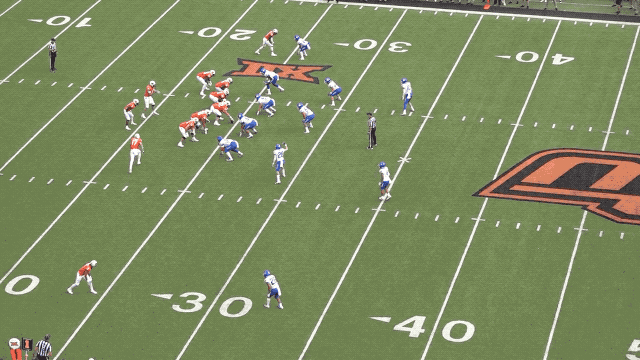
While much of the nation flocked to find the next dual-threat QB over the past decade, the trademark of Gundy's offenses has been strong-armed quarterbacks like Brandon Weeden and Mason Rudolph pushing the ball downfield to talented wideouts. Though these quarterbacks hardly possessed any threat to move the ball with their feet, the Cowboys could still maintain a positive box count against the run with the aforementioned RPOs but now also had the ability to attack both the full width and depth of the field thanks these young men with rocket launchers for right arms.
As college defenses evolved to feature more zone-based pattern-match schemes in that time, Gundy and Yurcich stayed one step ahead by eschewing typical practices. Instead of always spreading the field from sideline to sideline, they'd line up three receivers to the short side and dare the defense to roll their defense into the boundary.
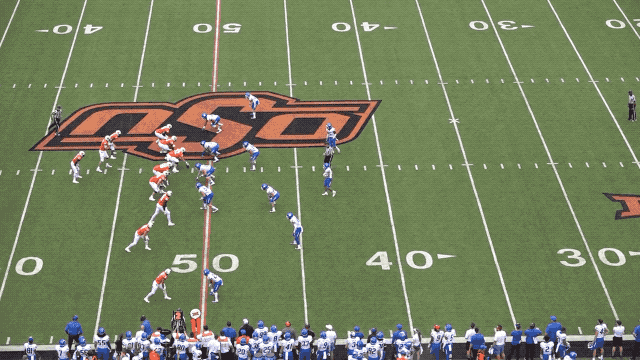
If the defense went too far in that direction, then they'd often be left with a one-on-one matchup to the field, regardless of the coverage called, leaving cornerbacks susceptible to double-moves.
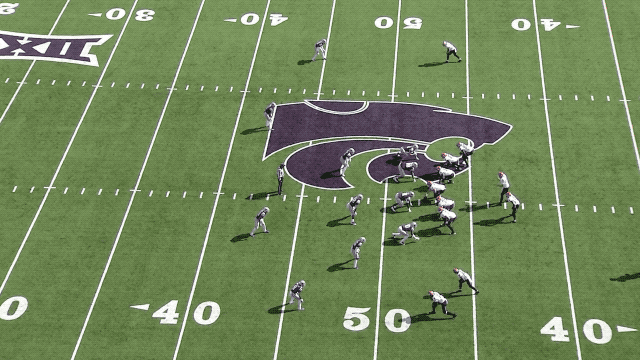
But although the Cowboys have stayed on the cutting edge conceptually for the past decade-and-a-half, the key to their success has not been the playbook, but rather the technique and execution of their quarterbacks and receivers. With the combination of great route-running technique and coverage recognition, Cowboy receivers are often 'thrown open' into spaces few anticipate.
In Yurcich's six-year run as coordinator, the Cowboys averaged 38 points and 478 yards-per-game, and won 10 games in a season four times, marking "the golden age of Oklahoma State football." In 2017, Yurcich led a unit that produced a 4,000-yard passer in Rudolph, two 1,000-yard receivers (including Biletnikoff winner James Washington), and a 1,000-yard rusher while leading the nation in passing yards (389.2), finishing second in total offense (568.9 ypg), and fourth in points-per-game (45.0).
Such numbers might be commonplace in the Big 12 but were seen for the first time at Ohio State this past fall, where Yurcich was announced as the new passing game coordinator one day after the Rose Bowl victory over Washington as Ryan Day officially took over the program.
But while Yurcich will have to replace four starters on the offensive line, three playmaking receivers, a 950-yard tailback, and oh yeah, the most prolific passer in Big Ten history, he's already proven capable of re-stocking a bare cupboard. After losing Rudolph and Washington to the NFL, the Cowboys rebounded with the nation's 10th-best unit in total offense (500.2 ypg) and saw former walk-on fifth-year senior QB Taylor Cornelius throw for 3,978 yards and 32 touchdowns this past fall while sophomore receiver Tylan Wallace emerged with 86 catches for 1,491 yards, the most of any player in a Power-5 conference and second overall in the nation.
Additionally, Yurcich will have more talent at his disposal than ever before in his 20 years of coaching. While the gap from Division-II to the Big Ten is obvious, Yurcich rarely had the chance to work with the kind of blue-chip talent he'll encounter in the Woody Hayes Athletic Center on a daily basis.
Despite Gundy's name and national reputation, the Cowboys never finished with a recruiting class higher than 27th nationally according to 247Sports during Yurcich's tenure. Even Rudolph, considered a four-star prospect, was ranked as the 269th-best recruit in the nation, and only the 16th-best pro-style QB.
While Rudolph's career proved just how meaningless such rankings may be, it's hard to overlook who Yurcich will be mentoring in his new job. As the leader of the QB room at the WHAC, Yurcich will be responsible for grooming the former #2 overall recruit in the nation, Justin Fields, along with former four-star recruit Matthew Baldwin.
Though it's unclear exactly what his role will be next to Day and fellow coordinator Kevin Wilson, Yurcich's resume makes him the perfect complement to that duo. While Wilson brings nearly 35 years of experience next to Day's time coaching with Chip Kelly in the NFL, Yurcich's time working outside the spotlight gives Ohio State a different viewpoint towards innovating.
After years of trying to simply overpower defenses with lesser talent, Day's vision may be to meld that style with that of Gundy, looking to always stay one step ahead of their opponents.
“I am really excited to announce that Mike is joining the Ohio State staff,” Day said in a statement upon his hiring. “Mike is not only an Ohioan coming home, but he is also an extremely talented coach who has enjoyed success throughout his career. His Oklahoma State offenses have been among the most proficient in college football and I look forward to welcoming and introducing Mike and his family to our staff, players and community.”
Like many coaches that didn't play at the highest levels, Yurcich had to work for everything that took him through 3 divisions and over 3,200 miles. His journey to Columbus may have not been as direct as some of his fellow Euclid natives, but as far as the Ohio State offense is concerned, that might not be a bad thing.
